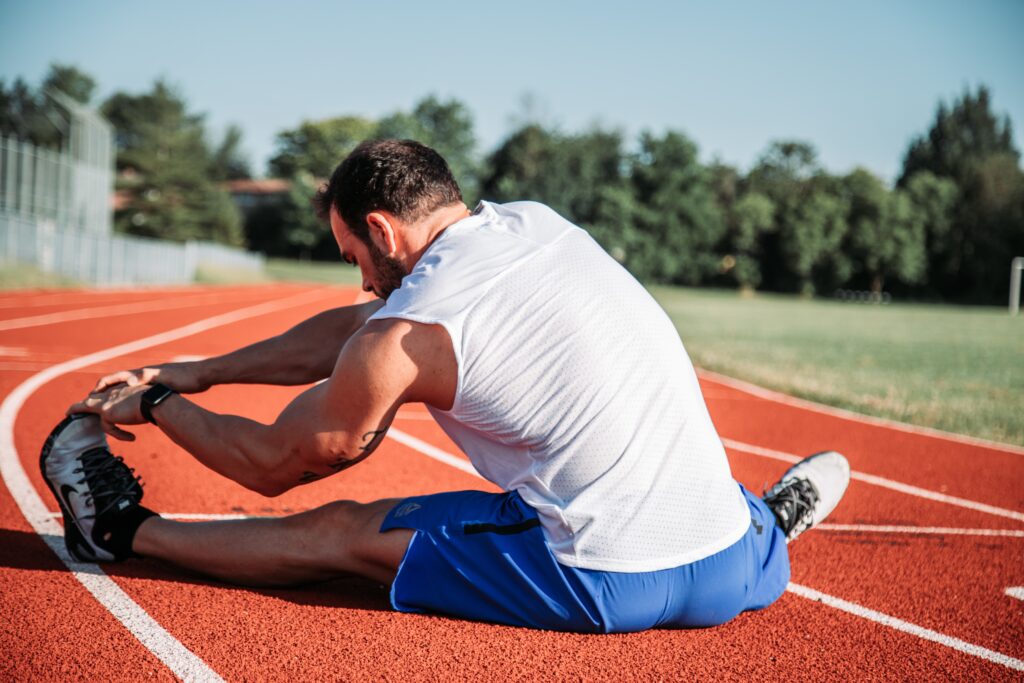Wikipedia defines “Stretching” as a form of exercise which is targeted at specific muscles or tendons making them flexed or stretched in order to gain an increase in muscle’s felt elasticity and acquire comfortable muscle tone. This results in increased flexibility and added range of motion for the body. Building muscle and achieving aerobic fitness is not all that our body needs. Achieving muscle flexibility is an equally important and necessary part of a physically fit body. Why stretching is important? It allows our muscles to gain flexibility, increase their strength and adds to the overall health of the muscles giving them the ability to maintain a range of motion in the joints. If muscles are not stretched they become stiff and tight which leads to pain and cramps. For example, if you have been sitting in a chair all day working on your computer, your leg muscles and hamstrings in the back of the thighs will get stiff. You will find it difficult to straighten up your legs and knees after hours of sitting in the same position. Similarly, after finishing a long day at work sitting in your office, when you get up you automatically raise your arms in the air and stretch. This behaviour is because your back and shoulder muscles require stretching to get relaxed. When stiff or shortened muscles are suddenly put to action, they are not ready and fall short to perform sudden strenuous activity which puts you at the risk of joint pain, strains and muscle damage.
It is generally believed that stretching is only done moments before you are going to perform an extensive physical activity. You may remember that in schools, we were trained to stretch before our physical education class. You might have also seen athletes performing different stretching exercise before the start of the game. This stretching is commonly known as warm-up exercise as it warms your muscles up and makes them ready for the extensive physical activity they are going to indulge in. Warmed up muscles mean that your muscles are relaxed and this helps to keep you away from any potential injuries during that activity.
Does stretching your muscles really help? And how often should you do stretching exercises in order to gain maximum benefit from it? One idea is well established that stretching helps your muscles relax and can loosen up stiff and tight muscles considerably. But stretching all the time and especially before going to sports or gym just like the athletes do may or may not be a good idea. There is a conflict of belief in various physical health experts on this. Recent research studies have found that static stretching in which you perform certain stretching exercises while holding yourself in one position such as touching your toes and holding your pose, can actually compromise your muscle performance. Your muscles might not perform to their full potential after a static stretch and then jumping into power activity such as jumping, running or sprinting.
“The Journal of Stretch and Conditioning Research”, published research which found that static stretching before weight lifting may affect your muscles in a negative way causing you to feel weaker during the actual workout. Another research conducted by the University of Zagreb found that static stretching compromised muscle performance of the participants by 2%. “The Scandinavian Journal of Medicine and Science in Sports also published a study in April 2010. This study combined the results of various other research works and concluded that a little amount of pre-participation stretching will decrease muscle’s ability to produce maximum force. However, it was less apparent from tests on muscle power. The study further declared that pre-participation stretching combined with other warm-up activities may counter the effect totally. It was also revealed that activities requiring a large range of motion in joints, such as gymnastics and ballet dancing, performers need to acquire certain level flexibility in muscles and joints before the show. The researchers stated that whether this can be achieved by stretching alone or by combining various other warm-up techniques with stretching has not been established in the literature as all the studies discussed static stretching only.
As a general rule, you should only focus on stretching muscles which you feel are causing you any problems, let alone full-body stretching. It’s easy to locate which body muscles require working on them. If you perform a stretch and don’t feel any tightness or discomfort in the involved muscles, it indicates you are good in that specific area. Thinking of stretching as just a warm-up tool or a cool-down exercise is a misconception among masses. You can stretch anytime throughout the day whenever you feel like doing it. One of the most productive ways to utilize free time at home while watching TV or during short work breaks is to perform casual light stretching to keep you active and relaxed. It takes away fatigue and keeps you refreshed. It is also important to understand that stretching is more effective when performed as a cool-down activity after a workout compared to taking it as a part of a warm-up routine. This is because your muscles are all pumped up and warm after a workout which makes it easier to stretch without the risk of any damage. Stretching before going to bed is also considered to be fruitful by many physical health experts. It’s a fact that our muscles rebuild and restore themselves during our sleep and stretching before sleep allows your muscles to refresh and become relaxed from all day long fatigue.
Doing a few stretches before a workout at the gym, or a football game, or as a start of the day exercise isn’t going to harm you anyway. Stretching is very important to acquire a certain level of flexibility in your body. If you are aiming at something at a professional level then you should consider stretching regularly to gain its benefits associated with flexibility.

